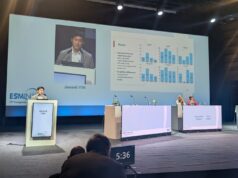
In patients with vertebrobasilar artery occlusion (VBAO) stroke undergoing mechanical thrombectomy, first-line contact aspiration appears to produce a greater first-pass effect (FPE) compared to a stent retriever-only approach. However, stent retriever-first techniques may yield better final reperfusion rates, resulting in no significant difference in overall clinical outcomes between the two. As such, researchers believe that technique selection based on the underlying occlusion aetiology may be critical, and further analyses are warranted to clarify this relationship.
These were the concluding messages delivered by Raul Nogueira (University of Pittsburgh School of Medicine, Pittsburgh, USA) at the 2025 World Stroke Congress (WSC; 22–24 October, Barcelona, Spain) based on new data from the ANGEL-COAST study—the findings of which Nogueira himself presented alongside co-investigator Dapeng Sun (Beijing Tiantan Hospital, Beijing, China).
In his presentation, Nogueira noted that the superior FPE observed with contact aspiration was “offset” by a reduction in successful final recanalisation, leading to similar 90-day functional outcomes between groups of patients randomised to each of the two thrombectomy techniques. The presenter also highlighted the fact that first-line aspiration was not associated with an increased risk of periprocedural complications or intracranial haemorrhage (ICH), while the procedural durations were comparable across both study groups.
ANGEL-COAST was a multicentre, prospective, open-label, blinded-endpoint randomised controlled trial that enrolled 338 VBAO acute ischaemic stroke patients across 22 sites in China, allocating these patients to receive either contact aspiration or stent retrieval as a first-line thrombectomy approach. Its primary endpoint was FPE—defined as expanded thrombolysis in cerebral infarction (eTICI) 2c/3 recanalisation after the first thrombectomy attempt, without any rescue strategies—while notable secondary outcomes of interest included successful recanalisation, use of rescue therapies, procedure times and 90-day modified Rankin scale (mRS) scores.
According to Nogueira, within intention-to-treat analyses, an FPE was observed in 43.5% of 170 patients in the first-line contact aspiration group versus 27.4% of 168 patients in the first-line stent retriever group (p=0.002). This statistically significant discrepancy translated to a treatment effect of 2.04, with the same trend also being present in per-protocol analyses of the study groups.
However, the study’s secondary endpoint measures revealed a more complex picture. While the FPE rate for complete recanalisation (eTICI 3) was also higher with aspiration versus stent retrieval (41.2% vs 25.6%, respectively), eTICI ≥2b50 recanalisation at the completion of each group’s assigned thrombectomy technique was more prevalent with stent retrieval (88.1%) compared to aspiration (78.2%)—and final eTICI ≥2b50 recanalisation at the end of the procedure was higher in the stent retriever group too (94% vs 87.6%, respectively).
Nogueira went on to note that rescue therapies were utilised at similar rates between the contact aspiration (45.3%) and stent retriever (46.4%) groups. Additionally, the median time from puncture to first-pass eTICI ≥2b50 recanalisation was 60 minutes in both groups, with the median time from puncture to either eTICI ≥2b recanalisation or the end of the procedure being marginally greater with aspiration (101 minutes) versus stent retrieval (97 minutes).
“So, yes—being fast is great, and speed is important, but it does not trump precision,” Nogueira commented. “You need to have both speed and precision.”
A number of more clinically oriented secondary endpoints also proved to be statistically comparable between the two first-line approaches assessed in ANGEL-COAST. The median change in National Institutes of Health stroke scale (NIHSS) score from baseline to 24 hours was -3 with aspiration versus -2 with stent retrieval, and 90-day quality-of-life assessments demonstrated parity across the two study groups as well. The median mRS score at 90 days in both groups was 4, while respective 90-day rates of mRS 0–2 and 0–3 were 24.7% and 35.9% with aspiration compared to 26.8% and 38.7% with stent retrieval. Nogueira was quick to point out that, despite trending towards better clinical outcomes with stent retrievers, these differences were not statistically significant, and other safety measures including rates of mortality, periprocedural complications and ICH also appeared comparable between the two study groups.
“Additional analyses and future studies are still needed to identify subgroups that might derive greater benefit—this time, a clinical benefit—with one strategy versus the other,” he concluded. “I don’t think we are done with the overarching question assessed in this trial. There may be meaningful interactions based on underlying aetiology—for example, stent retriever approaches could prove superior in intracranial atherosclerotic disease [ICAD], while contact aspiration might perform better in cardioembolic occlusions. These are fascinating possibilities, and we need to analyse the clinical outcomes of both techniques in these specific patient populations.”











